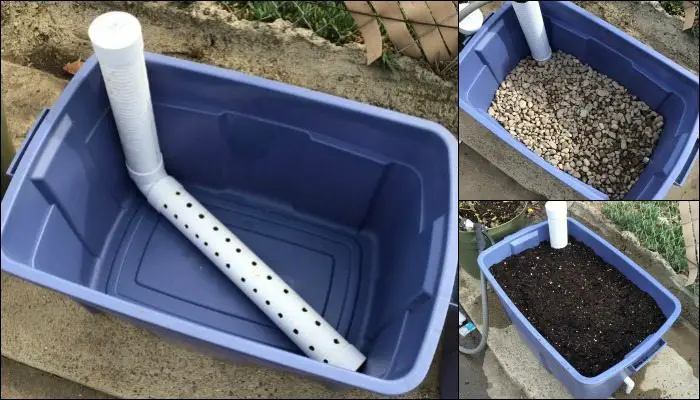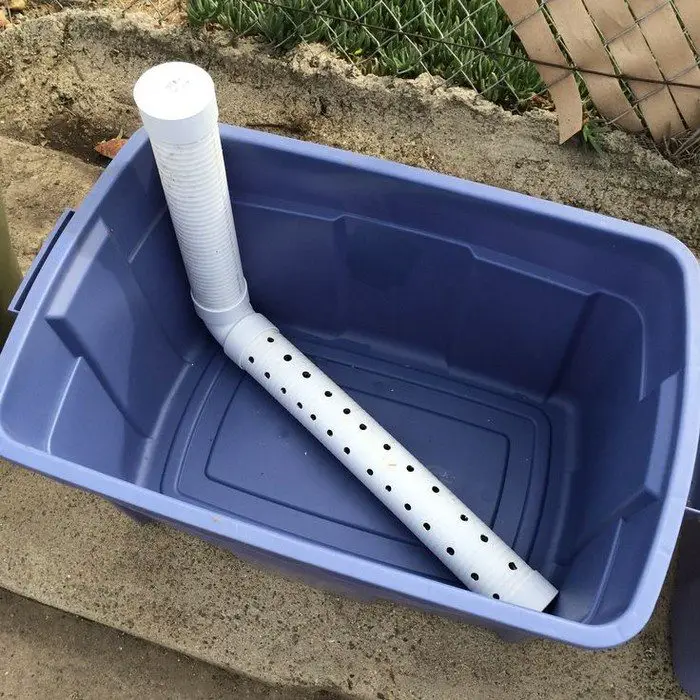Living in a generally dry area can make growing produce a little more difficult for some gardeners. If you are one of those who want to make sure that your plants are well hydrated, a wicking bed is one idea that will improve your garden.

This wicking garden bed container is perfect for small gardens, for those who live in the city for instance, or that don’t have decent soil to grow plants in.

As a gardener living in California, this wicking bed container was made in the owner’s effort to help reduce water consumption and waste while making sure his plants don’t get dehydrated. Through a wicking bed container, the water supply stays below the soil, therefore, preventing water from evaporating. Because the water is down beneath the main roots, the system promotes a strong, healthy root system with the plants taking up just the right amount they need. It’s a bit like hydroponics without the ‘hydro’ :)
Plant science also suggests that watering from the bottom also reduces the risk of fungal infections and wind and sunburn, especially on soft-leaf plants.

Does this sound like a project your garden needs? Take a look at more wicking bed examples from our gallery and a link to a complete tutorial below to help you build your own!
Contents
Building a Wicking Garden Bed Container
Materials
- Tub / Container
- 3″ Pipe
- Gravel
- Potting Soil
- Shade Cloth
Tools
- Drill
- Pipe Cutter
Instructions
Step 1: Prepare the Container
- Select a suitable container that fits the space available and the amount of produce you wish to grow. Ensure it has no cracks or holes above the intended water reservoir level.
Step 2: Create a Water Reservoir
- Cut the 3-inch pipe to a length that is a few inches shorter than the height of your container. This will serve as the fill pipe for your reservoir.
- Drill multiple holes throughout the bottom half of another segment of the 3-inch pipe. This will be submerged in the gravel to allow water to seep out.
Step 3: Install the Fill Pipe and Overflow
- Position the drilled pipe horizontally at the bottom of the tub. This will act as the water distribution system.
- Place the fill pipe vertically so that it reaches from the bottom to the top of the container. Ensure it’s accessible from the top for easy filling.
- Drill an overflow hole in the side of the container, just above the level of the horizontal pipe. This will prevent overwatering by allowing excess water to escape.
Step 4: Add Gravel
- Pour gravel over the horizontal pipe until the base of the tub is covered by about 2-3 inches of gravel. This layer will act as the water reservoir.
Step 5: Add a Water Inlet Barrier
- Cut the shade cloth to cover the gravel layer. This will prevent soil from mixing into the gravel but allow water to wick upwards.
Step 6: Add Soil and Plants
- Fill the container with a high-quality potting soil up to the desired level. Leave enough room for planting.
- Plant your seeds or seedlings into the potting soil. Choose plants that are suitable for the depth of the container and the climatic conditions.
Step 7: Water the Garden Bed
- Fill the reservoir through the vertical fill pipe using a hose or watering can. Fill until water begins to escape through the overflow hole.
- Water the topsoil initially to settle everything in place.
Click on any image to start the lightbox display. Use your Esc key to close the lightbox.![]()












You can get more step-by-step instructions here…
Benefits of Wicking Garden Bed Containers
Wicking garden bed containers offer a unique solution for gardeners aiming to conserve water while ensuring their plants thrive. These innovative systems are particularly beneficial in areas where water conservation is crucial or where gardeners face challenging soil conditions. Below are the key advantages of using a wicking garden bed container.
Water Efficiency
One of the most significant benefits of a wicking garden bed container is its water efficiency. The design allows water to wick upwards from a reservoir below, directly to the plant roots. This method minimizes evaporation and runoff, making every drop count. By reducing the frequency of watering and maximizing the use of available water, a wicking garden bed container is an excellent choice for drought-prone areas.
Consistent Moisture Supply
The consistent moisture level is another advantage of a wicking garden bed container. Plants in traditional garden setups can suffer from fluctuating water levels, which can stress plants and affect their growth. A wicking garden bed container maintains a steady level of moisture, which promotes healthier plant roots and optimizes growth conditions without the risk of overwatering.
Reduced Labor and Maintenance
Gardening can be labor-intensive, especially when it comes to watering. A wicking garden bed container simplifies this process by reducing the frequency of waterings needed. This not only saves time but also makes gardening more accessible for people with limited physical ability or those who cannot tend to their gardens daily.
Versatility and Portability
Wicking garden bed containers are versatile and can be set up in various settings, including urban balconies, rooftops, or compact yards. They can be built in different sizes to fit available space, making them ideal for city dwellers who want to grow their own food or flowers but have limited space.
Healthier Plants and Soil
Finally, a wicking garden bed container promotes healthier plants and soil. By watering from the bottom up, it reduces the chances of soil erosion and nutrient runoff. This method also decreases the likelihood of leaf diseases and fungal infections that are common with top watering. Plants develop stronger root systems as they grow downward to access moisture, resulting in overall healthier growth.
Enhanced Water Conservation
Wicking garden bed containers excel in water conservation, a crucial aspect in areas facing water restrictions. By confining water to a closed system, these containers prevent significant water loss, making them ideal for sustainable gardening practices.
Reduced Weed Growth
The design of wicking garden bed containers often leads to reduced weed growth. Since the water supply is below the soil surface, less water reaches the surface layer where weed seeds typically germinate. This results in less weeding and lower maintenance for gardeners.
Improved Plant Growth in Poor Soil Conditions
Wicking garden bed containers are especially beneficial for areas with poor soil conditions. Since the containers are filled with potable soil, plants can thrive regardless of the native soil quality in the area. This feature makes it possible to grow a variety of plants that might not otherwise prosper.
Extended Growing Season
The controlled environment of a wicking garden bed container can help extend the growing season. The soil in the container can stay warmer longer than ground soil, which is particularly beneficial in early spring or late fall. This allows gardeners to start their season earlier and extend it longer than traditional gardening methods.
Cost-Effective Gardening
Over time, using a wicking garden bed container can be cost-effective. The reduced need for water and lower maintenance can save money on water bills and gardening supplies. Additionally, the durability of these containers means they can be used year after year with minimal replacement costs.
Eco-Friendly Gardening
Wicking garden bed containers support eco-friendly gardening practices. By optimizing water use and enabling gardening in recycled containers, these systems help reduce the ecological footprint of gardening. This makes them an appealing choice for environmentally conscious gardeners.
Incorporating a wicking garden bed container into your gardening strategy can lead to a more productive and less labor-intensive gardening experience, making it an excellent choice for both novice and experienced gardeners alike.
Plant Selection for Wicking Beds
Choosing the right plants for your wicking garden bed container is crucial for maximizing the benefits of this innovative gardening method. Wicking beds are versatile and can support a wide range of plants, from vegetables to ornamentals, provided the right conditions are met.
Here’s a guide to selecting plants that will thrive in a wicking garden bed container.
Ideal Vegetables for Wicking Beds
Wicking garden bed containers are perfect for growing a variety of vegetables, especially those that require consistent moisture levels. Some of the best vegetables to grow include:
- Tomatoes: These thrive on consistent watering, making them ideal for wicking systems.
- Lettuce and Greens: Leafy greens such as spinach, kale, and swiss chard perform well due to the constant water availability.
- Root Vegetables: Carrots, beets, and radishes benefit from the deep, moist soil that wicking beds provide.
Suitable Herbs for Wicking Systems
Herbs generally prefer well-drained conditions, but several varieties adapt well to the moist environment of a wicking garden bed container. These include:
- Mint: Known for its invasive roots, containing mint in a wicking bed can prevent it from overtaking other garden areas.
- Parsley and Basil: Both herbs enjoy the steady moisture that wicking beds offer, promoting lush, healthy growth.
- Chives: These are low-maintenance and thrive in the consistent moisture of a wicking bed.
Best Fruits for Wicking Beds
Fruit-bearing plants can also prosper in a wicking garden bed container, especially those that appreciate more water. Consider these options:
- Strawberries: They love the stable moisture levels and can spread easily in the contained space of a wicking bed.
- Blueberries: With the correct soil pH adjustments, blueberries can thrive due to the consistent water availability.
- Dwarf Fruit Trees: Certain dwarf varieties of fruit trees, like citrus and apple, can do well in larger wicking beds with adequate depth.
Optimal Flowers and Ornamentals
Wicking garden bed containers aren’t just for edible plants; they also support beautiful ornamental plants. Here are some flowers that are particularly suited to wicking conditions:
- Marigolds: These vibrant flowers can add color to your garden and thrive in moist conditions.
- Impatiens: Known for their shade tolerance, impatiens also enjoy the consistent moisture in wicking beds.
- Ferns: Various ferns appreciate the humid environment provided by wicking beds and can add a lush, green look to your garden setup.
Considerations for Plant Selection
When selecting plants for a wicking garden bed container, consider the depth of the container and the mature size of the plants. Ensure there is enough space for root development and adequate surface area for plants to spread without overcrowding. Additionally, be mindful of the water needs of each plant—while wicking beds provide consistent moisture, some plants may prefer drier conditions and could require modifications to their growing environment.
Choosing the right plants for your wicking garden bed container will ensure a thriving garden that utilizes water efficiently and produces a bountiful harvest or a beautiful display of flowers.
Conclusion
Building a wicking garden bed container is a practical and efficient way to ensure your plants receive consistent moisture, leading to healthier growth and less frequent watering needs. This method not only saves water but also allows for gardening in diverse environments and conditions. As you explore this sustainable gardening option, you’ll likely find it to be a rewarding addition to your green space.
For more convenient gardening solutions, check out our hand held seed planter project!





